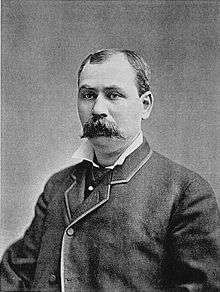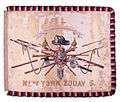Thomas F. Byrnes
| Thomas F. Byrnes | |
|---|---|
 Photograph of Byrnes published in his 1886 book Professional Criminals of America | |
| Born |
June 15, 1842 Dublin, Ireland |
| Died |
May 7, 1910 (aged 67) Manhattan, New York |
Thomas F. Byrnes (June 15, 1842 – May 7, 1910) was an Irish-born American police officer, who served as head of the New York City Police Department detective department from 1880 until 1895, and gained national attention for his exploits.
Biography
Born in Dublin, Ireland to James and Rose Byrnes, he immigrated to New York as a child. He worked as a skilled gas-fitter until the start of the Civil War. He enlisted with Elmer E. Ellsworth's "Zouaves" in 1861 and served two years with that unit. After his service, Byrnes became a firefighter, joining Hose Company No. 21 in New York City. He remained as a firefighter until December 10, 1863, when he was appointed a police officer.[1]

Byrnes rose in the ranks, first as a patrolman, then becoming a sergeant in 1869 and a captain in 1870. He gained renown through solving the Manhattan Savings Bank robbery of 1878. He became Detective Bureau chief in 1880.[2] As inspector, Byrnes quickly won national distinction. He increased the detective force from 28 to 40 men. In four years it made 3,300 arrests. In 1882, he obtained legislative approval of changes in the department which gave him immense power. In 1886, Byrnes instituted the "Mulberry Street Morning Parade" of arrested suspects before the assembled detectives in the hope they would recognize suspects and link them to more crimes. Also that year, his book Professional Criminals of America[3] was published. He built up a book of photographs of criminals, which he called the "Rogues Gallery".

Byrnes' brutal questioning of suspected criminals popularized the term "the third degree",[4] which was apparently coined by Byrnes. From the descriptions, the third degree as practiced by Byrnes was a combination of physical and psychological torture.[5]
Jacob A. Riis, who as police reporter for the New York Sun knew Byrnes well, declared that he was "a great actor", and hence a great detective. Riis called him an unscrupulous "big policeman" and a veritable giant in his time.[6]
In 1891, three years after publicly criticizing London police officials on the way they handled the Jack the Ripper investigations, Byrnes was faced with a similar crime in New York. Amid mammoth publicity, Byrnes accused an Algerian, Ameer Ben Ali (nicknamed Frenchy) of the crime. He was convicted despite the evidence against him being doubtful, but pardoned eleven years later.[7] Byrnes also successfully obtained a confession from gang leader Mike McGloin, who was convicted and executed for the murder of a tavern-owner during a robbery.
In 1895, the new president of the New York City Police Commission, future President of the United States Theodore Roosevelt, compelled him to resign as part of Roosevelt's drive to rid the force of corruption.[8] In later life, Byrnes became an insurance investigator, opening a detective agency on Wall Street.
The television documentary Secrets of New York episode of 22 October 2013 credited Byrnes as "a man who invented America's modern detective bureau."[9]
Death
At his death in 1910, he was survived by his wife Ophelia and five daughters.
In fiction
Byrnes was featured as a fictional character in Jack Finney's time travel novel, Time and Again, and has now and then been a character in other historical novels. In addition, he was a character in the juvenile detective series, Broadway Billy, as well as a number of other detective "dime novels". His name appeared as the author on the fictional turn-of-the-century true-crime novel The Bone Collector, which was featured in the film The Bone Collector. Byrnes also appeared in Caleb Carr's novel The Alienist.
References
- ↑ History of the New York Fire Department, Ch. 32, Part II
- ↑ New York Press article about Byrnes, by William Bryk Archived June 27, 2004, at the Wayback Machine.
- ↑ Byrnes, Thomas. Professional Criminals of America Vol 3. New York: Cassell and Company 1886.
- ↑ Archived March 16, 2006, at the Wayback Machine.
- ↑ XIII. Roosevelt comes—Mulberry Street’s Golden Age. Riis, Jacob A. 1901. The Making of an American
- ↑ America The Story of Us — Episode 7: Cities — History.com
- ↑ Wolf Vanderlinden, “The New York Affair” Ripper Notes -- part one issue 16 (July 2003); part two #17 (January 2004), part three #19 (July 2004 ISBN 0-9759129-0-9)
- ↑ Investigative Historical Timeline
- ↑ Secrets of New York We the Italians